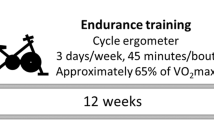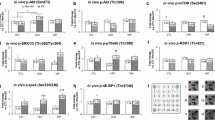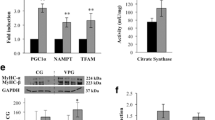Abstract
Myostatin decreases muscle mass and this is accomplished, in part, by inhibiting muscle satellite cell proliferation and differentiation by regulating the expression of cell cycle-related proteins (e.g. p21 and cdk2) and myogenic regulatory factors (e.g. myogenin and MyoD). The purpose of this investigation was to determine whether protein ingestion before and after a resistance exercise (RE) bout affects myostatin and cell cycle-related gene expression. Strength-trained middle-aged to older men were divided into a protein group (61.4 ± 4.3 years, n = 9) or a placebo group (62.1 ± 4.2 years, n = 9). Muscle biopsies from the vastus lateralis muscle were taken at rest and 1 and 48 h after a 5 × 10 repetition leg press RE bout. Protein (15 g whey) or non-caloric placebo was taken immediately before and after the RE bout. mRNA expression levels of myostatin and related genes (AcvrIIb, FLRG, p21, p27, cdk2, myogenin and MyoD) were determined by Taqman probe-based real-time RT-PCR and normalized to GAPDH mRNA. Myostatin mRNA decreased after a RE bout, but only in the placebo group (P ≤ 0.05). Conversely, myostatin-binding protein FLRG and cell-cycle kinase cdk2 mRNA increased only in the protein group (P ≤ 0.05). p21 mRNA was increased at 1 h post-RE in placebo (P ≤ 0.05) and tended to be increased in the protein group (P = 0.08). Myostatin, its binding protein and cell cycle-related gene expressions are affected by single RE bout and these responses are further modified by whey protein intake. Therefore, controlling nutrition intake is important when studying gene expression responses to exercise.




Similar content being viewed by others
References
Adams GR, Caiozzo VJ, Haddad F, Baldwin KM (2002) Cellular and molecular responses to increased skeletal muscle loading after irradiation. Am J Physiol Cell Physiol 283(4):C1182–C1195
Adams GR, Haddad F, Baldwin KM (1999) Time course of changes in markers of myogenesis in overloaded rat skeletal muscles. J Appl Physiol 87(5):1705–1712
Allen DL, Roy RR, Edgerton VR (1999) Myonuclear domains in muscle adaptation and disease. Muscle Nerve 22(10):1350–1360
Andersen LL, Tufekovic G, Zebis MK, Crameri RM, Verlaan G, Kjaer M, Suetta C, Magnusson P, Aagaard P (2005) The effect of resistance training combined with timed ingestion of protein on muscle fiber size and muscle strength. Metabolism 54(2):151–156
Atkinson G (2001) Analysis of repeated measurements in physical therapy research. Phys Ther Sport 2:194–208
Atkinson G (2002) Analysis of repeated measurements in physical therapy research: multiple comparisons amongst level means and multifactorial designs. Phys Ther Sport 3:191–203
Bickel CS, Slade JM, Haddad F, Adams GR, Dudley GA (2003) Acute molecular responses of skeletal muscle to resistance exercise in able-bodied and spinal cord-injured subjects. J Appl Physiol 94(6):2255–2262
Bogdanovich S, Krag TO, Barton ER, Morris LD, Whittemore LA, Ahima RS, Khurana TS (2002) Functional improvement of dystrophic muscle by myostatin blockade. Nature 420(6914):418–421
Bohe J, Low A, Wolfe RR, Rennie MJ (2003) Human muscle protein synthesis is modulated by extracellular, not intramuscular amino acid availability: a dose-response study. J Physiol 552(Pt 1):315–324
Brooks SV, Faulkner JA (1990) Contraction-induced injury: recovery of skeletal muscles in young and old mice. Am J Physiol 258(3 Pt 1):C436–C442
Burke DG, Chilibeck PD, Davidson KS, Candow DG, Farthing J, Smith-Palmer T (2001) The effect of whey protein supplementation with and without creatine monohydrate combined with resistance training on lean tissue mass and muscle strength. Int J Sport Nutr Exerc Metab 11(3):349–364
Chauvigne F, Gabillard JC, Weil C, Rescan PY (2003) Effect of refeeding on IGFI, IGFII, IGF receptors, FGF2, FGF6, and myostatin mRNA expression in rainbow trout myotomal muscle. Gen Comp Endocrinol 132(2):209–215
Crameri RM, Langberg H, Magnusson P, Jensen CH, Schroder HD, Olesen JL, Suetta C, Teisner B, Kjaer M (2004) Changes in satellite cells in human skeletal muscle after a single bout of high intensity exercise. J Physiol 558:333–340
Cribb PJ, Hayes A (2006) Effects of supplement timing and resistance exercise on skeletal muscle hypertrophy. Med Sci Sports Exerc 38(11):1918–1925
Dreyer HC, Blanco CE, Sattler FR, Schroeder ET, Wiswell RA (2006) Satellite cell numbers in young and older men 24 hours after eccentric exercise. Muscle Nerve 33(2):242–253
Esmarck B, Andersen JL, Olsen S, Richter EA, Mizuno M, Kjaer M (2001) Timing of postexercise protein intake is important for muscle hypertrophy with resistance training in elderly humans. J Physiol 535(Pt 1):301–311
Gibala MJ, MacDougall JD, Tarnopolsky MA, Stauber WT, Elorriaga A (1995) Changes in human skeletal muscle ultrastructure and force production after acute resistance exercise. J Appl Physiol 78(2):702–708
Greenlund LJS, Nair KS (2003) Sarcopenia—consequences, mechanisms, and potential therapies. Mech Ageing Dev 124(3):287–299
Guernec A, Chevalier B, Duclos MJ (2004) Nutrient supply enhances both IGF-I and MSTN mRNA levels in chicken skeletal muscle. Domest Anim Endocrinol 26(2):143–154
Hill JJ, Davies MV, Pearson AA, Wang JH, Hewick RM, Wolfman NM, Qiu Y (2002) The myostatin propeptide and the follistatin-related gene are inhibitory binding proteins of myostatin in normal serum. J Biol Chem 277(43):40735–40741
Hulmi JJ, Volek JS, Selänne H, Mero AA (2005) Protein ingestion prior to strength exercise affects blood hormones and metabolism. Med Sci Sports Exerc 37(11):1990–1997
Hulmi JJ, Ahtiainen JP, Kaasalainen T, Pollanen E, Häkkinen K, Alen M, Selanne H, Kovanen V, Mero AA (2007) Postexercise myostatin and activin IIb mRNA levels: effects of strength training. Med Sci Sports Exerc 39(2):289–297
Häkkinen K, Kallinen M, Izquierdo M, Jokelainen K, Lassila H, Malkia E, Kraemer WJ, Newton RU, Alen M (1998) Changes in agonist-antagonist EMG, muscle CSA, and force during strength training in middle-aged and older people. J Appl Physiol 84(4):1341–1349
Jeanplong F, Bass JJ, Smith HK, Kirk SP, Kambadur R, Sharma M, Oldham JM (2003) Prolonged underfeeding of sheep increases myostatin and myogenic regulatory factor Myf-5 in skeletal muscle while IGF-I and myogenin are repressed. J Endocrinol 176(3):425–437
Joulia-Ekaza D, Cabello G (2007) The myostatin gene: physiology and pharmacological relevance. Curr Opin Pharmacol 7(3):310–315
Joulia D, Bernardi H, Garandel V, Rabenoelina F, Vernus B, Cabello G (2003) Mechanisms involved in the inhibition of myoblast proliferation and differentiation by myostatin. Exp Cell Res 286(2):263–275
Kadi F, Schjerling P, Andersen LL, Charifi N, Madsen JL, Christensen LR, Andersen JL (2004) The effects of heavy resistance training and detraining on satellite cells in human skeletal muscles. J Physiol 558(Pt 3):1005–1012
Kim JS, Cross JM, Bamman MM (2005) Impact of resistance loading on myostatin expression and cell cycle regulation in young and older men and women. Am J Physiol Endocrinol Metab 288(6):E1110–E1119
Langley B, Thomas M, Bishop A, Sharma M, Gilmour S, Kambadur R (2002) Myostatin inhibits myoblast differentiation by down-regulating MyoD expression. J Biol Chem 277(51):49831–49840
Lee SJ (2007) Quadrupling muscle mass in mice by targeting TGF-ss signaling pathways. PLoS ONE 2(8):1–7:(e789)
Lee SJ, McPherron AC (2001) Regulation of myostatin activity and muscle growth. Proc Natl Acad Sci USA 98(16):9306–9311
Liu W, Saint DA (2002) Validation of a quantitative method for real time PCR kinetics. Biochem Biophys Res Commun 294:347–353
Magee TR, Artaza JN, Ferrini MG, Vernet D, Zuniga FI, Cantini L, Reisz-Porszasz S, Rajfer J, Gonzalez-Cadavid NF (2006) Myostatin short interfering hairpin RNA gene transfer increases skeletal muscle mass. J Gene Med 8(9):1171–1181
Malumbres M, Ortega S, Barbacid M (2000) Genetic analysis of mammalian cyclin-dependent kinases and their inhibitors. Biol Chem 381(9, 10):827–838
Manninen AH (2006) Hyperinsulinaemia, hyperaminoacidaemia and post-exercise muscle anabolism: the search for the optimal recovery drink. Br J Sports Med 40(11):900–905
McCroskery S, Thomas M, Maxwell L, Sharma M, Kambadur R (2003) Myostatin negatively regulates satellite cell activation and self-renewal. J Cell Biol 162(6):1135–1147
McPherron AC, Lawler AM, Lee SJ (1997) Regulation of skeletal muscle mass in mice by a new TGF-beta superfamily member. Nature 387(6628):83–90
Nakazato K, Hirose T, Song H (2006) Increased myostatin synthesis in rat gastrocnemius muscles under high-protein diet. Int J Sport Nutr Exerc Metab 16(2):153–165
Nosaka K, Sacco P, Maeatari K (2006) Effects of Amino Acid Supplementation on Muscle Soreness and Damage. Int J Sport Nutr Exerc Metab 16(6):620–635
Olsen S, Aagaard P, Kadi F, Tufekovic G, Verney J, Olesen JL, Suetta C, Kjaer M (2006) Creatine supplementation augments the increase in satellite cell and myonuclei number in human skeletal muscle induced by strength training. J Physiol 573:525–534
Paddon-Jones D, Sheffield-Moore M, Zhang XJ, Volpi E, Wolf SE, Aarsland A, Ferrando AA, Wolfe RR (2004) Amino acid ingestion improves muscle protein synthesis in the young and elderly. Am J Physiol Endocrinol Metab 286(3):E321–E328
Phillips SM, Tipton KD, Aarsland A, Wolf SE, Wolfe RR (1997) Mixed muscle protein synthesis and breakdown after resistance exercise in humans. Am J Physiol 273(1):E99–107
Raue U, Slivka D, Jemiolo B, Hollon C, Trappe S (2006) Myogenic gene expression at rest and after a bout of resistance exercise in young (18–30 yr) and old (80–89 yr) women. J Appl Physiol 101(1):53–59
Rios R, Carneiro I, Arce VM, Devesa J (2002) Myostatin is an inhibitor of myogenic differentiation. Am J Physiol Cell Physiol 282:C993–C999
Salehian B, Mahabadi V, Bilas J, Taylor WE, Ma K (2006) The effect of glutamine on prevention of glucocorticoid-induced skeletal muscle atrophy is associated with myostatin suppression. Metabolism 55(9):1239–1247
Schuelke M, Wagner KR, Stolz LE, Hubner C, Riebel T, Komen W, Braun T, Tobin JF, Lee SJ (2004) Myostatin mutation associated with gross muscle hypertrophy in a child. N Engl J Med 350(26):2682–2688
Taylor WE, Bhasin S, Artaza J, Byhower F, Azam M, Willard DH Jr, Kull FC Jr, Gonzalez-Cadavid N (2001) Myostatin inhibits cell proliferation and protein synthesis in C2C12 muscle cells. Am J Physiol Endocrinol Metab 280(2):E221–E228
Terova G, Bernardini G, Binelli G, Gornati R, Saroglia M (2006) cDNA encoding sequences for myostatin and FGF6 in sea bass (Dicentrarchus labrax, L.) and the effect of fasting and refeeding on their abundance levels. Domest Anim Endocrinol 30(4):304–319
Thalacker-Mercer AE, Fleet JC, Craig BA, Carnell NS, Campbell WW (2007) Inadequate protein intake affects skeletal muscle transcript profiles in older humans. Am J Clin Nutr 85(5):1344–1352
Tipton KD, Wolfe RR (2001) Exercise, protein metabolism, and muscle growth (2001) Int J Sport Nutr Exerc Metab 11(1):109–132
Tipton KD, Rasmussen BB, Miller SL, Wolf SE, Owens-Stovall SK, Petrini BE, Wolfe RR (2001) Timing of amino acid-carbohydrate ingestion alters anabolic response of muscle to resistance exercise. Am J Physiol Endocrinol Metab 281:E197–E206
Tipton KD, Elliott TA, Cree MG, Aarsland AA, Sanford AP, Wolfe RR (2007) Stimulation of net muscle protein synthesis by whey protein ingestion before and after exercise. Am J Physiol Endocrinol Metab 292:E71–E76
Wagner KR, Liu X, Chang X, Allen RE (2005) Muscle regeneration in the prolonged absence of myostatin. Proc Natl Acad Sci USA 102(7):2519–2524
Wang J, Walsh K (1996) Resistance to apoptosis conferred by Cdk inhibitors during myocyte differentiation. Science 273(5273):359–361
Welle S, Bhatt K, Pinkert CA (2006) Myofibrillar protein synthesis in myostatin-deficient mice. Am J Physiol Endocrinol Metab 290(3):E409–E415
Willoughby DS (2004) Effects of an alleged myostatin-binding supplement and heavy resistance training on serum myostatin, muscle strength and mass, and body composition. Int J Sport Nutr Exerc Metab 14(4):461–472
Yang W, Zhang Y, Li Y, Wu Z, Zhu D (2007) Myostatin induces cyclin D1 degradation to cause cell cycle arrest through a phosphatidylinositol 3–kinase/AKT/GSK-3 beta pathway and is antagonized by insulin-like growth factor 1. J Biol Chem 282(6):3799–3808
Acknowledgments
The authors thank Tuomas Kaasalainen, Tuovi Nykänen, Risto Puurtinen, and Aila Ollikainen for their help in data collection and analysis. We also thank the very dedicated group of subjects who made this project possible. We thank Härmä Food Ltd. for providing the drinks. Finnish Ministry of Education and the Finnish Cultural Foundation supported this research.
Author information
Authors and Affiliations
Corresponding author
Rights and permissions
About this article
Cite this article
Hulmi, J.J., Kovanen, V., Lisko, I. et al. The effects of whey protein on myostatin and cell cycle-related gene expression responses to a single heavy resistance exercise bout in trained older men. Eur J Appl Physiol 102, 205–213 (2008). https://doi.org/10.1007/s00421-007-0579-4
Accepted:
Published:
Issue Date:
DOI: https://doi.org/10.1007/s00421-007-0579-4




